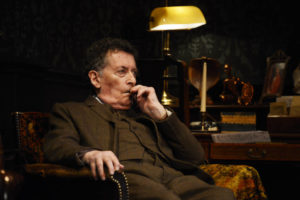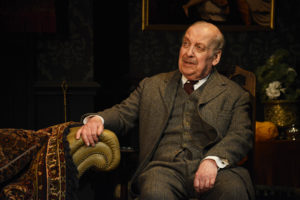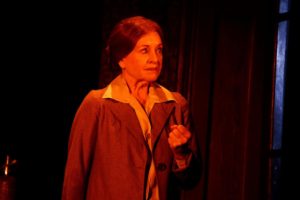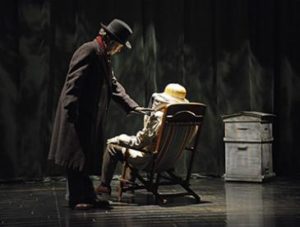We grow up with our heroes, and they grow with us; when we are young, they seem like giants, gods – incomparable, unbeatable, undefeated. But legends fade and heroes grow old. They even die, sometimes. In The Final Curtain (a new play presented by Theatre Royal Bath Productions and Kenny Wax), even the great Sherlock Holmes is fading; slower, frailer, more frayed at the edges, as he faces the phantoms of mystery and mortality – and its one of the best theatre experiences I’ve ever had.
Companionably estranged from his partner in crime/ life, Dr John Watson, a retired Sherlock Holmes (Robert Powell) is living out his twilight years on the South coast of England, with bees to keep, and rheumatism and paranoia to keep at bay. His adventure-less existence is thrown into disarray when a figure from his past re-emerges: Mary Watson (Liza Goddard), the estranged wife of his dear Doctor, who claims to have seen visions of her long-dead son James in 221B Baker Street, and wants Sherlock out of retirement and on the case.
The story is beautifully, intricately crafted by writer Simon Reade; the language is elegant and artful, and Reade captures the heart, soul and style of these iconic characters whilst also holding the audience in delicious suspense right to the very last second. The title, The Final Curtain, evokes another literary sleuth’s final investigation – namely, Curtain: Poirot’s Last Case, by Agatha Christie. Both Poirot and Holmes’ final cases are filled with melancholy meditations on their lives and careers, and whether they were right to sacrifice their own potential happiness for the good of Queen and Country. After all, their deeds are history, and their godliness is tarnished by the undeniable proof of their mortality.
Because Holmes isn’t as young and spritely as he used to be; he suffers from rheumatism, so much so that, with a heavy heart, he cannot play his beloved Stradivarius. and this is shown in stark relief by one of the most subtly heart-breaking exchanges of the play. With his iconic self-assured straightforwardness, Holmes informs the Lestrade-like policeman at a crime scene that he is familiar with 140 different types of tobacco; to which the officer replies, ‘Didn’t it use to be 220?’ In one interaction, Holmes is heartbreakingly marked out as being barely half the man he used to be.
The same cannot be said of the sensational Robert Powell, who, after a long and celebrated career, is at the very pinnacle of his acting prowess. His Holmes isn’t a performance as much as it is a complete inhabitation of the character, so natural that you really feel he has lived a whole life in Sherlock’s shoes. From the first moment he appears, in which he mischievously introduces himself as Sherlock Smith, Powell commands the stage with effortless elegance and a strength of purpose that grounds the character even as Holmes fears he is somewhat losing his touch. His interactions with Roy Sampson’s superb, sophisticated Mycroft were particularly touching; they inhabit the classic characters so fully, so intricately, that I quite forgot I was watching a play and felt as though I truly was observing an actual conversation between two real brothers.
As a lifelong fan of Doyle’s detective duo, I am always very particular about how Dr Watson is portrayed; the danger is that he has the potential to fall somewhere on the extreme ends of the scale, being alternately portrayed either as a priggish grump (like Ian Hart in BBC’s 2002 version of The Hound of the Baskervilles) or as a bumbling idiot (like Nigel Bruce in Basil Rathbone’s series of Holmes movies in the 1930s/40s). Happily, then, that Timothy Knightley portrays a wonderfully avuncular, earnest and sweet take on the character that is true to the spirit of Dr Watson, whilst amusingly emphasising his pulpy over-dramatization of his and Holmes’ cases. Seeing Holmes and Watson side by side, in the flesh, was a real treat, and their interactions – and it’s adorable that, even after all this time, Watson is still falling for Holmes’s disguises.
Although Holmes and Watson only infrequently share the stage, their relationships forms a huge part of the tale – as ever it should. No explicit reason is given for the duo’s relative estrangement, though it’s heavily implied that the cracks began to form when Watson got married and started his own family. Although Watson contributes little cerebral value to their investigations that Holmes does not already possess – other than his medical training and military experience – Watson’s primary role is as Holmes’ chronicler and humaniser. And, more than that, Watson is the beating human heart to Holmes’ more clinical mind.
Though there is a Watson who can match Sherlock beat for beat in terms of intellect and eloquence: Mary, wonderfully played by Liza Goddard, who is definitely not a member of the Sherlock Holmes fan club. Goddard, famous for more comedic roles, thrives in the complex, dramatic character of Mary Watson, who isn’t afraid to confront Holmes with his demons and his duty. Mary points out that the only mystery Holmes couldn’t solve was marriage; and although Watson perceived himself as primarily a ‘whetstone for Holmes’ mind’, Mary observes that Holmes’ relationship with Watson – ‘my Watson’, as he refers to him at one point – was more a marriage than hers ever was. The full extent of their affection – fraternal, romantic, spiritual – is left for us to decide.
Deftly and dynamically directed by David Grindley, the drama zips along at a deceptively breakneck pace, and I was genuinely shocked when the curtain fell to signal the end of act 1. As important as the impassioned speeches and melancholy monologues are, Grindley isn’t afraid to let the quiet moments linger – one of the most tense, characterful and gripping parts of the play is the scene in which Powell’s Holmes calmly and methodically puts on a dressing gown and adjusts the chairs in his room. Really. It’s but a microcosm of this production’s talents across the board.
The splendid set was cannily designed by Jonathan Fensom to make the titular curtain central to the story both metaphorically and literally, swathed as it is in dark green drapes and featuring just enough props to suggest such diverse locations as a 1920s BBC recording studio, a lush London park, and Holmes’ private beach. Jason Taylor’s excellent lighting and Gregory Clarke’s evocative sound design really brought the sets to life, making forests and oceans out of the minimalist scenery. Between each scene, the curtains would be drawn across the stage, revealing new locations with the effortless artistry of a magic trick. The first reveal of 221B’s Baker Street’s elegantly ramshackle bachelor pad was, for a Holmes fan, just like stepping into Willy Wonka’s Chocolate Factory, and seeing it brought to life on the stage in such a way was profoundly emotional – even more so when Holmes and Watson were reunited in their purgatorial paradise.
The play grapples with heavy themes of legacy, responsibility, and the changing times – how it feels to grow old, when one has lived such a life as Holmes has, and where one fits into the ever-evolving landscape of modern life. 221B Baker Street has been irrevocably changed by the time Holmes finally returns to it, filled with a messy juxtaposition of past (represented by the Renaissance-era paintings Mary hangs on the wall) and the future (represented by the electronic doorbell Miss Hudson recently had installed). A disguised Holmes even poses the question ‘Who needs a god when you have a gadget?’, vocalising our present-day fears about the increasing indispensability of technology in our daily lives. Holmes and Watson are pre-analogue relics in an analogue age, obstinately clinging to the past, mistrustful of the new technologies and mindsets. But, it’s the bringing together of the old and the new that solves the mystery and brings closure. And yet, in a chilling final scene, the play refuses to fully give us that closure we crave; the final mystery, the lingering questions, are ours to ponder as the titular curtains falls for the final time.
And for all you horror fans out there, there are some seriously Gothic undertones that lend an entertainingly unearthly quality to proceedings. The world’s only consulting detective is called onto examine his own demons as well as investigating the possibility that some supernatural shenanigans are afoot. The name of Professor James Moriarty surfaces more than once, a spectre of Sherlock’s greatest adversary, and There’s also a fair bit of doubling, one of the most effective uses of which comes quite early on and which was so well done it really has to be seen in person. Mary Watson visits Holmes’ seaside abode to see him lounging in a sun chair near his bee hives – only to realise it’s not Holmes at all, but a waxwork duplicate. As the scene goes on, the double sits in the chair between Holmes and Mary, eerily present and unmoving. Does it represent Holmes now, stagnating and useless in his retired life? Or perhaps it represents the other Watson, the one Holmes has distanced himself from, but who remains a stalwart presence in Holmes’ mind? Or does it represent James, the Watsons’ dearly departed son, for whose death his parents are locked in a frozen state of perpetual grief? Again, the play entrusts these questions to its audience, for them alone to judge and decide.
The play likewise leaves the question of heroism up to us: does the intent or the action make you heroic? The short term successes, or the long term lessons? Holmes has always been an enigmatic, complex hero, and his incarnation here is no different. Now, more than ever, he is a hero for our times: the kind who, despite personal trauma and sorrow, keeps fighting the good fight against wickedness, and to hell with the odds.
Thrilling, enthralling and insightful, Sherlock Holmes: The Final Curtain is theatre as it should be. If you’re a Holmes fan, you’ll be enraptured by this new play; if you’re not, you’ll be swept along by the remarkably talented cast and crew the dynamic, haunting mystery at its heart.





